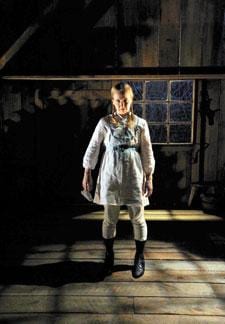If memory serves, the last truly terrifying thing Toronto theatre audiences faced was Melissa GIlbert’s song stylings in Little House, The Musical. If that didn’t scare the bejesus out of you, just wait until you catch Theatrefront’s four-part horror series, The Mill.
Parts one and two of the massive project opened last October to petrified patrons and rapturous reviews: Matthew MacFadzean’s Now We Are Brody and Hannah Moscovitch’s The Huron Bride both struck theatre gold with chilling stories of the people of Brody, a rural Canadian pioneer town.
We’re not just talking about a frightening lack of bug spray, flush toilets and salon-quality hair products – this town has enough murders, hauntings and possessions to satisfy the most hard-core horror fan.
The Woods is the third installment in the series, courtesy of queer writer Tara Beagan (Thy Neighbour’s Wife). She reaches back to a time before Brody was settled, a time when Jesuit missionaries are first spreading their religious message to the First Nations of Quebec and Ontario.
Marie (played by Michelle Latimer) and her daughter Lyca (Holly Lewis) enjoy a contented existence alone in the woods. Ostracized from their community, the two struggle to maintain their Wendat (the traditional name of the Huron) way of life in the face of an increasing French presence. Industrialization encroaches on the land they hold sacred.
“The Wendat were very much in the midst of the trade networks in Quebec and Ontario and had a lot of contact with the Europeans,” says Beagan. “They were quite amenable to Christian conversion, but [they were] very susceptible to the epidemics brought over by the settlers and lost a great deal of their population.”
MacFadzean approached Beagan with his original play and an outline of The Mill’s story arc. He asked the playwright to add her own voice to the series. Beagan was interested but forthright about what she wanted to bring to the table.
“If we’re dealing with Canada’s history, my voice is going to be First Nations,” she says. “It’s coming on strong, and I’m not going to be pulling any punches.” Beagan was excited by the series’ thrilling premise and embraced the tone set by The Mill’s other writers.
The Wendat tradition of careful custodianship of the land played a large part in crafting the story for The Woods. Beagan’s writing is deeply inspired by First Nations history and her own Ntlaka’pamux heritage. The Woods is written in that vein.
Director Sarah Stanley, the lesbian former artistic director of Buddies in Bad Times Theatre, found Beagan’s story both fascinating and worrisome.
“The Woods takes place during the conquest mentality of the free world,” she says. “It’s really chilling because it’s historically accurate and paints this incredibly rich and horrific truth that we are living on borrowed land.”
Despite that history of subjugation, Stanley feels there is more unity between the two cultures than one might think.
“This nation was born on First Nation principles, but we choose not to realize it,” she says. “John Ralston Saul proposes this idea that we’re all really Métis in his book Reflections of a Siamese Twin. If we acknowledge that, then we can begin to grow and prosper together, but until that time, there can only be horror.”

 Why you can trust Xtra
Why you can trust Xtra


